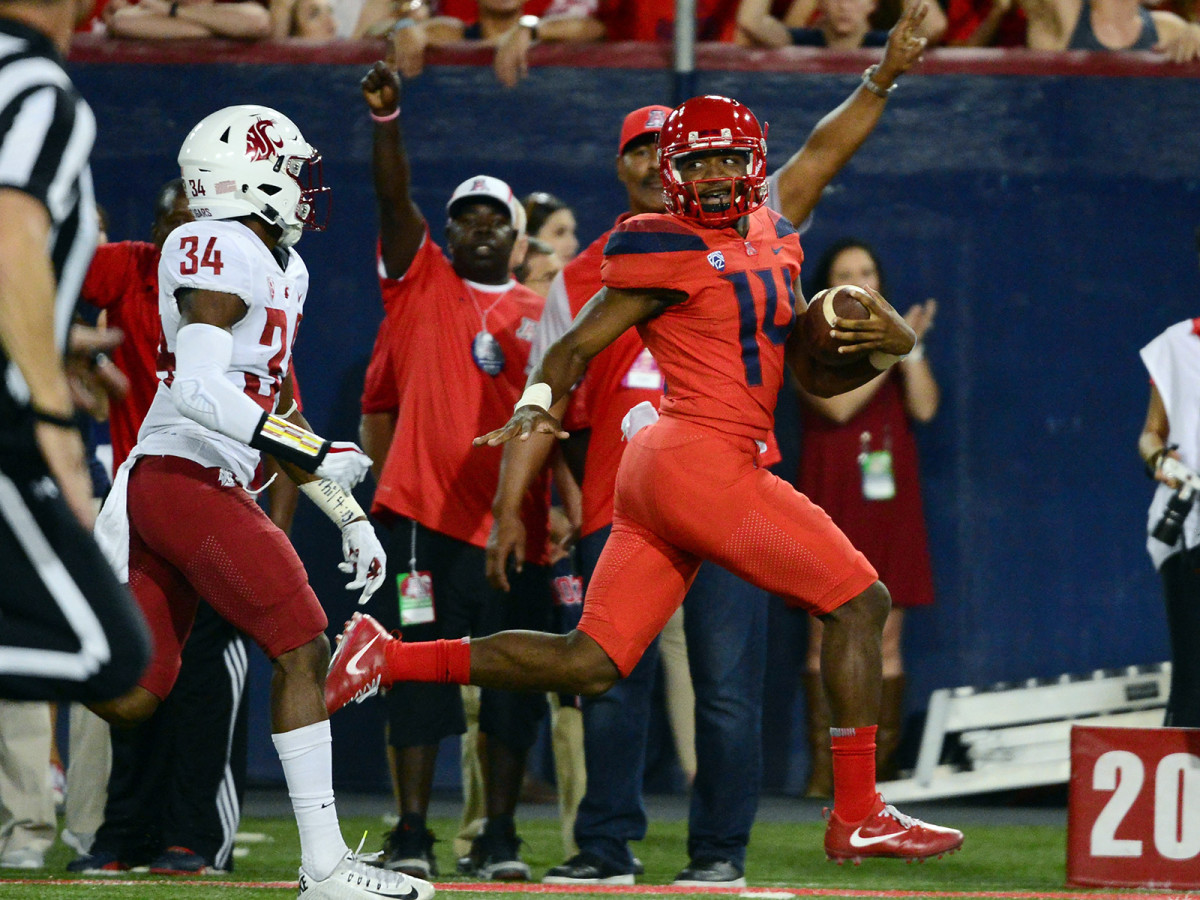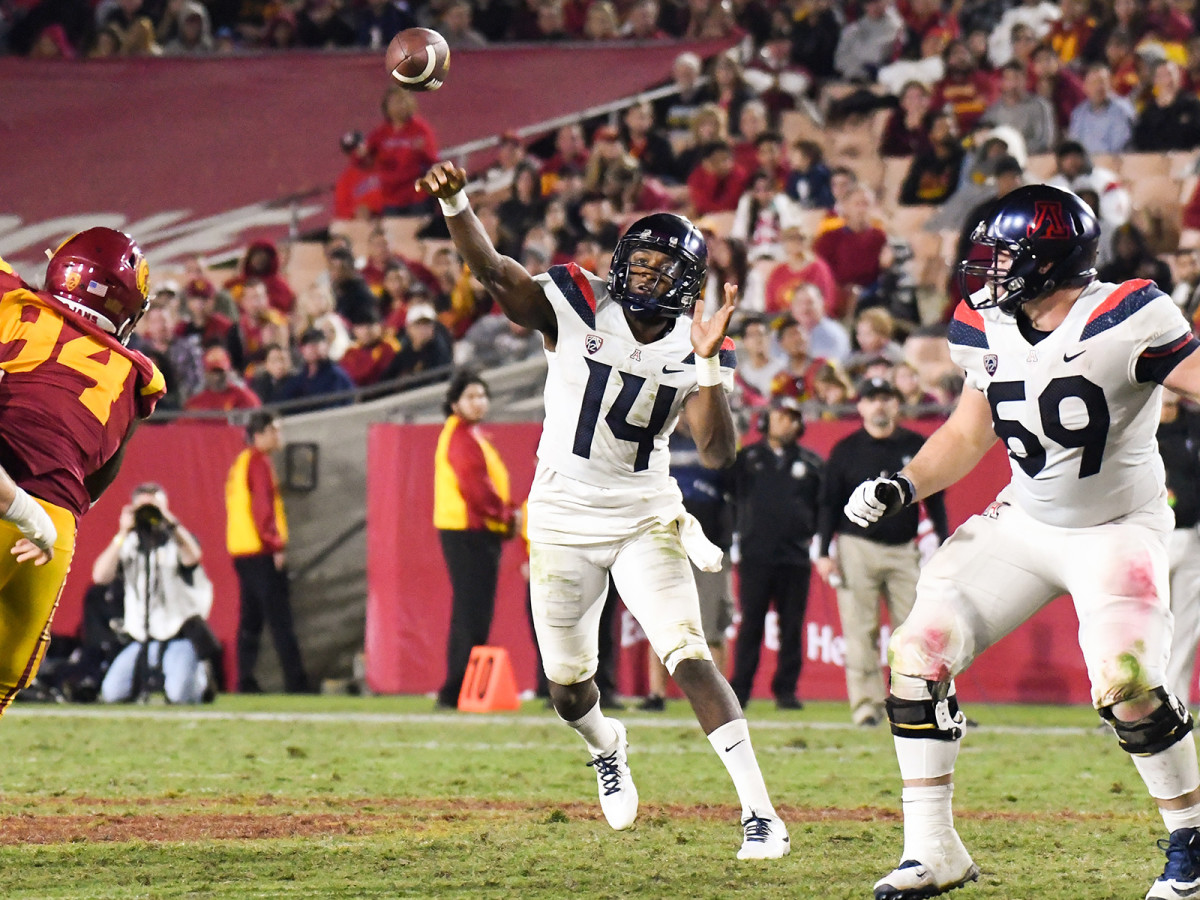Khalil Tate Is Done Waiting, Whether the Rest of the Nation Is Ready or Not

This story appears in the Aug. 13, 2018, issue of Sports Illustrated. For more great storytelling and in-depth analysis, subscribe to the magazine—and get up to 94% off the cover price. Click here for more.
The jersey hung off of Khalil Tate’s tiny frame, the bottom dangling down to his knees and the sleeves hiding his small hands. Akili Tate lent his three-year-old brother an old youth football jersey because Khalil begged. What little Khalil really wanted was to play tackle football with his brother and the other six-year-olds and so, in his big, baggy jersey, he quietly crept onto the field, slipping into a line of boys during pre-practice stretching. When the coach booted him, he’d cry to his mother, and she’d tell him the same thing she always told him: Wait.
It was like the time later, as an eighth-grader, when he traveled with his brother on the summer 7-on-7 circuit, tagging along with an older group and occasionally participating in a practice by rifling 70-yard passes to high school receivers. They’d turn to their coach and ask: “Why can’t he play in the games?”
So he waited, and he waited.
Khalil Tate has spent much of his 19 years waiting. He waited to finally play tackle football at age five, and when the coach put his son in at quarterback and stuck Khalil at defensive end, he waited the next year to play the position he wanted to. He waited in high school, at last winning the starting quarterback job midway through his junior season. Khalil waited in college, too, at Arizona, getting his shot a month into his sophomore season only after starter Brandon Dawkins suffered an injury.
Finally, the wait for Khalil Tate is over. He put a thunderous ending to it all last fall, erupting for one of the most sensational six-week stretches in history, a series of games in which a little-known backup quarterback thrust himself into Heisman Trophy contention.
Tate wowed the country with his big-play ability over the six-game span, rushing for eight touchdowns of at least 45 yards each, completing seven scrambling deep balls of more than 40 yards and stunning the sport with his offensive productivity: 1,207 yards rushing—12 yards per carry—957 yards passing and 19 total touchdowns.
The 6'2", 215-pound Tate wasn’t running like a quarterback either. He sought out contact like a big, burly running back, shaking off arm tacklers and shouldering into defenders. He outran defensive backs and slashed away from speedy linebackers, making cuts in the open field like a silky, smooth receiver. As his mother, Lesli, says: “It almost looks like he’s skating.”
He ran for more yards in a single game, 327 on Oct. 7 against Colorado, than any other quarterback in NCAA history, and his 840 rushing yards last October were the most by a Football Bowl Subdivision player at any position in that month in over a decade.
It was a satisfying moment for someone who at Junipero Serra High in Gardena, Calif., was categorized by recruiting services as an “athlete” and not a quarterback, a recruit who some schools wanted as a defensive back. “I’ve always been the underdog, even in high school. I wasn’t superrecruited. Didn’t get invited to Elite 11, The Opening, none of that,” he says, of high school showcases. “A lot of guys were ranked ahead of me. Funny to see if you look at those lists now, and it’s like, ‘Huh, O.K.’ I’ve always been the underdog. I enjoy that. I like to let people know that you can go from one day being nothing to the next day being the talk of the world.”
Back in Inglewood, “They all knew,” Khalil says, but “for everyone else, it was like, ‘Who’s that guy and where did he come from?’”

Across the kitchen, Brian Tate’s eyebrows scrunch up. What the heck is his son trying to tell him?
Khalil is flashing hand signals and before Brian can decipher them, his wife, Lesli, barks out the answer, “Drink water!” or “Go eat dinner!” or “Take a nap!” Khalil is slowly teaching his parents sign language, and his mother is learning it quickest.
Khalil is scheduled for his fourth class of sign language this semester at Arizona. Overall he is an honor student, with a GPA north of 3.0, something he keeps to himself, his father says. Khalil is studying Information Science & eSociety, a new major at the school.
Khalil’s social media classes got personal last October, when Twitter campaigns—#Khalil4Heisman, for instance—became a teaching lesson. When tweets, some his, were projected on the screen in front of the class, Khalil slumped into his chair. He’s a shy kid. He says, “Everybody looking at me like, ‘That’s him!’”
That’s what happens when you go from seldom-used backup to big-time star in days. By October, Khalil was a talking point for coaches and players at Serra, a coeducational private Catholic school with an enrollment of about 400. Before practice cranked up each Monday last October, they’d gather around to chat about their now famous alum, “Did you see him do that!?” says Serra defensive backs coach Marvin Pollard. “It was like every time you looked up, he was on SportsCenter’s Top 10 [plays].”
There was his scrambling 30-yard TD pass on fourth down and 161 rushing yards against USC and the deep bomb he perfectly placed for a 56-yard score versus Cal. There was the jaw-dropping highlight when five Oregon State players missed him on an 18-yard touchdown run. There was the video game moment against UCLA, when he nearly fumbled a snap, broke two tackles in the backfield and turned on the jets for a 71-yard score.
“I knew he was going to be a great player,” Brian Tate says, “I didn’t know he was going to be this good.”
Khalil does not have a tattoo, his father proudly notes, and his ears aren’t pierced. Brian, a school teacher, and Lesli, a pharmacy assistant, were strict on their two boys, filling their schedules with schoolwork and sports. “It can be treacherous out here. Sports got us away from a lot of different things,” says Akili, now 22 and working as a freelance filmmaker and videographer.
Inglewood is 15 miles southwest of downtown Los Angeles, and low-flying planes routinely roar overheard, a constant reminder of its intimacy with LAX. About one-quarter of its residents live below the poverty line, according to the 2010 U.S. Census, and gang violence and drug activity are not uncommon, but the area got a boost recently. The city was picked as the home of Los Angeles Stadium at Hollywood Park, an open-air stadium and entertainment district that will house the Los Angeles Rams and Chargers.
Its opening is not scheduled until 2020, but already a goliath of concrete and steel protrudes into the blue California sky, in perfect view from Darby Park, the birthplace of Tate’s football career. Gary Bass points at the partially built stadium from a large patch of green and brown grass, the place Khalil first learned to dodge defenders and toss TD passes, helping lead Bass’s Inglewood Jets to four youth league Super Bowls and, at one point, a 40-game winning streak that spanned multiple years.
The park is secluded, encircled by trees on three sides and a black gate on a fourth, separating it from a steep dropoff, to the valley and the stadium’s construction zone. Darby Park has changed for the better since Khalil’s days here. Officials installed a soft orange walking track, and the fields are more carefully manicured. A large community gymnasium welcomes visitors to the park, and on this day a sign is posted out front that speaks to the unfavorable situations for some in this area: “Free meals,” it reads, “for kids and teens.”
The biggest influence on Khalil: 73-year-old Ejai Ramsey, whom he calls Oma—a word roughly translated as grandma. Oma has recently learned to text, battling autocorrect and refusing to use the backspace function to the amusement of the rest of the family. An accomplished athlete in her youth growing up in Compton in South Central Los Angeles, Oma later dominated as a pitcher in adult softball leagues. “She could fire that ball,” Brian says.
Oma showed Khalil how to pass the football, how to crossover dribble and how to throw a stiff arm. She grew up a Lakers fanatic, purchasing a handful of tickets for her family every year and attending every championship parade, and she passed that fandom along to her daughter Lesli.
Khalil grew up tailgating at UCLA football games while a cousin, Manuel White, later a fourth-round draft pick, played running back for the Bruins. Brian’s grandfather played for Prairie View A&M in the 1930s, and in Khalil’s room he has a black-and-white team photo of his great-grandpa wearing a leather helmet. Maybe that lineage explains Khalil’s vision and instinct, the two things Brian says separate him from others. “That’s something you can’t teach. It’s born in.” Khalil’s time as a basketball point guard helped, too, as did a summer spent on former USC and NFL receiver Keyshawn Johnson’s 7-on-7 team. Johnson organized trips to college campuses along with his team’s 7-on-7 tournaments, which Lesli says was a “turning point” in her son’s career.
Serra High is special to the Tates. Khalil’s uncle, father and brother are graduates, and Khalil served as a ball boy for the varsity as a young teen. The lowest-priced tuition plan on the school’s website is $8,400 a year, and sending Khalil there required sacrifice. “We wanted to know when we dropped him off, he’d be safe,” Lesli says. Serra’s campus in Gardena is seven miles from their home. Despite being the smallest of the three Catholic schools in the district, it has recently produced some of football’s most talented receivers: Washington’s Paul Richardson, Jacksonville’s Marqise Lee and the Rams’ Robert Woods were receivers on the Cavaliers’ 2009 state championship team. On a sunny July day, Pollard, the Serra assistant and a former cornerback at USC, sits on blue-painted wooden bleachers facing an unremarkable football field that does not match this school’s historic success. “I hope they’ll give back,” Pollard says of the NFL players. “I know Khalil will.”
Khalil waited behind an incumbent starter for his first two years at Serra. Just when he was about to get his chance, a 6'5", 225-pound senior quarterback named Caleb Wilson transferred onto the team after his father joined the USC coaching staff. Khalil wondered if he’d now be stuck behind a new guy. “I watched Khalil, and I knew this was going to bring the best out of him,” Pollard says. “He was like, ‘I will not lose this position.’”
Khalil won the starting position for good in the sixth game of that junior season and then went on a blitz that earned him a nickname still used around Serra: The Sheriff. In 10 of the final 15 games of Khalil’s high school career, he ran and passed for more than 100 yards, and that stretch doesn’t include a 523-yard, eight-touchdown outing in the final game of his junior year. He had at least 200 yards rushing and passing in three of those games and posted a pair of six-touchdown, 500-yard performances as a senior that finally got college coaches thinking he could play quarterback at the next level.
Lesli had been frustrated by Khalil’s recruitment and rankings—he was not a five-star, not even listed by 247Sports within the top-10 of the Athlete rankings—so she created a website for her son, posting his highlights and his gaudy high school stats: 7,168 total yards and 82 touchdowns. He eventually received 15 scholarship offers that allowed him to play quarterback. On a recruiting visit, USC coach Clay Helton told Khalil, “When you run the ball, you run like a running back,” but Khalil did not want to play running back. The toughest part of all this was explaining to a 17-year-old kid the “adult politics” of college sports, Brian says. “Nothing was ever given to him.”
Nobody was more committed to Khalil the passer than Arizona’s Rich Rodriguez. Helton knows now Khalil made the right move, calling him “an unbelievable fit” for Arizona’s system.
Oma helped him, says Lesli. She had twice beaten breast cancer, the last time in 2008, undergoing a double mastectomy and 37 radiation treatments. During that time she was living with Khalil’s family, and the boys saw her fight the disease as she continued her job as a social worker. She still throws the football with Khalil today. “For her to go through all of that,” Khalil says, “I’ve really got to make her proud.”

On Sept. 22 the Wildcats fell to Utah, 30–24. For a second straight game, Khalil, a sophomore, did not take a snap, stuck behind starter Brandon Dawkins as Arizona fell to 2–2. On the field after the game, a Utes assistant coach approached the Wildcats’ backup QB, “Glad, they didn’t play you,” he told him.
The coach’s comments got Khalil thinking: I should be playing. In a meeting a few days later he told that to coach Rich Rodriguez. “I’m only 19, but I know what I want,” he says. “I knew I had to ask him, ‘What can I do to get on the field?’ ”
He spent the next weekend, a bye week, in Los Angeles and told his former high school coach, “If they put me on the field, they’re not going to be able to take me off.” He got his chance when Dawkins was injured in a sideline collision on the opening drive of Arizona’s game at Colorado on Oct. 7.
On his third snap, on a zone-read option play where he faked out nearly the entire left side of the defense, Khalil sprinted for a 58-yard touchdown. On his fourth play, he completed a 28-yard pass. On his ninth snap, he ran for a 28-yard score. He finished with 481 yards and five scores as Arizona began a four-game winning streak.
Rodriguez’s firing two months later, in the wake of a sexual harassment suit, shook the Tates. He was like family. But the hiring of Rodriguez’s replacement, Kevin Sumlin, was, says Khalil, “from God.” Sumlin and Khalil were already acquainted: Sumlin, a rare believer in Tate as a quarterback, had recruited him to Texas A&M. Noel Mazzone, Arizona’s new offensive coordinator, had recruited him too, while coaching at UCLA. “Funny how we all ended up in the same place,” Khalil says.
Sumlin and Mazzone are tweaking Rodriguez’s spread-centric, QB-run heavy scheme to what Khalil describes as a more NFL offense, asking him to make more “next-level reads” in an offense that includes more passing from the pocket. Sumlin’s offense had turned Johnny Manziel into a Heisman Trophy winner at College Station, and Helton predicts that Tate will “continue to be a pain in the butt.”
Comparisons between Manziel and Tate are all around. Khalil is the next Johnny Football, they say. He’s a right-handed Michael Vick, others proclaim, or he’s a West Coast Lamar Jackson.
Tate begins this season in the spotlight: a Heisman trophy candidate and the leader of a team expected to make some noise in the Pac-12. He knows he’ll have to be extra special this year, if he is to claim the top individual prize in college football. At a school with a 24-year conference championship drought and one that routinely kicks off after 9 p.m. ET, the hill is steep. The waiting may not be quite over for Khalil Tate, but his time has come.
